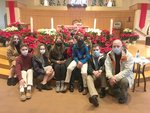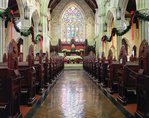


COVENTRY — Hope has traditionally been the theological virtue most closely associated with the Christmas season: throughout Advent we look forward in joyful expectation to the moment of the Incarnation, the entry of the divine into human history and the beginning of Christ’s mission of salvation. It is a virtue that is especially precious to Rhode Islanders (who proudly bear “Hope” as the state’s motto), and it is one which this past year has brutally tested the faithful as a people of God. An unprecedented global health crisis, difficult conversations about racial justice, the inability for many of the faithful to receive the sacraments in their accustomed fashion, and a bitterly divisive presidential election have required each of us to hope in God’s healing in a new and frequently demanding way.
It was in this spirit of hope that Catholics throughout our diocese gathered to celebrate Christmas this year — although, as we have come to expect after the past several months, Christmas in 2020 looked quite a bit different from celebrations in previous years.
“We had to use a ticket-based system this year,” said Father Michael J. Woolley, pastor of SS. John and Paul Church in Coventry. “Parishioners could request them online beforehand, and we kept a careful count as people entered the building to make sure that we didn’t exceed the permitted capacity.”
Like many churches of its size, SS. John and Paul had its congregation capped at 125 parishioners for Mass this year — a mere fraction of the usual turnout for what is typically the busiest Mass of the year.
Although the pews may have only been filled to a quarter of their capacity, in accordance with state COVID-19 pandemic regulations, parishioners who were not able to join in person made use of the streaming service the church offered via Facebook Live. Nearly 700 people tuned in to the live stream of the midnight Mass, which included a unique twist to help the experience feel a bit more immersive.
“Bring an (electric) torch, Jeanette, Isabella!” the church’s bulletin proclaimed, jocularly referring to the French Christmas Carol “Un flambeau, Jeannette, Isabelle!” SS. John and Paul has a tradition of celebrating their Midnight Mass “by stable-light” — that is to say, with only candles and choir lights providing illumination to the church. In order to replicate this experience at home, parishioners were encouraged to “turn off their lights and plug in their tree” before streaming the Mass to their device.
Like SS. John and Paul, Holy Apostles Church in Cranston had to employ a reservation system this year to make sure that parishioners could remain socially distanced while worshipping.
“Our family made sure to make our reservations as soon as it was possible,” said parishioner Renee McInnis.
This proved to be a wise course of action — all available seats for the church’s Christmas vigil were reserved within hours of being made available online. For members of the parish unable to attend Mass in person, Holy Apostles offered an innovative live stream which employed multiple cameras at different angles, creating a greater sense of depth and presence than most traditional streams.
Although many churches made use of the internet to help adapt their Christmas liturgies, some parishes also experimented with more low-tech solutions. A notable example is St. Mary’s Church in Newport, which attempted to simplify the registration process by offering “old school” paper tickets — appropriate, perhaps, for one of the most historic parishes in the diocese.
“We have many older parishioners who don’t always feel comfortable using the internet, so this made things much simpler for them,” explained Father Kris Von Maluski, the pastor at both St. Mary’s and nearby St. Augustine’s Church. “We had already experienced a bit of a challenge with registration because the church’s history makes it very popular with tourists and visitors — which is usually a blessing, although it can make social distancing very difficult.”
This paper-based system had the added bonus of making sure that regular parishioners had first consideration when it came to reserving seats for Mass.
“It was a tough decision, because we didn’t want anyone to feel excluded or unwelcome, but we also wanted to make sure that the members of our community who have been here every week throughout the pandemic were able to be here for Christmas as well,” Father Von Maluski explained.
“It was a concern for us because of the church’s architecture — although it looks like we have an enormous amount of space, the pews were laid out long before social distancing was an issue, and trying to safely arrange parishioners can sometimes feel like playing Tetris.”
Like other churches in the diocese, St. Mary’s also offered a streaming liturgy this year. One innovative twist to their live stream was the inclusion of “sing-along” style captions, allowing online viewers to join in the hymns.
For many Catholics throughout the diocese, the most remarkable thing about Christmas Mass this year was how familiar the service felt despite the changes brought about by the pandemic.
“All of the really important things were still the same,” said Claire Flaherty, a parishioner at SS. Rose and Clement Church in Warwick.
“The liturgy, the music, and the decorations were the same as always — except that Father [Andrew] Messina moved our statue of Mary to the choir area near the altar, which really helped to increase her visibility and make her feel more present with us.”
Although every parish in the diocese found its own unique way of celebrating Christmas in the midst of a pandemic, each of them was united in joining the call expressed by Pope Francis in his “Urbi et Orbi” Christmas blessing this year: that the faithful “must work to bring hope and help to all who suffer and are alone.”
In his homily at SS. John and Paul, Father Woolley cited Servant of God Takashi Nagai as a prime example of this sense of hope. Nagai was a physician at the Nagasaki Medical College Hospital who was on duty when the city was struck by an atomic bomb; he described the challenge of maintaining hope in the aftermath of the bombing in his best-selling book “The Bells of Nagasaki: A Message of Hope.”
The title of the book is taken from an incident which took place on Christmas Eve, 1945 — a mere four months after the bomb fell. Workers digging through the ruins of Urakami Cathedral were able to unearth one of the church’s bells intact, and quickly set it up on a tripod just in time to ring in Christmas for the war-torn city.
In the words of Father Woolley, the tolling of the bell “rang out throughout the city louder than ever, with no trees or buildings to dampen it, and sounding like the multitude of the heavenly host proclaiming the birth of the Prince of Peace… And the same Glory of the Lord that shone in Nagasaki shines for us today, in a world once again afflicted by the powers of death and destruction in the form of a terrible pandemic.”
These sentiments were echoed by Father Von Mulaski, who said that he hopes his parishioners will remember that our need to hope in God has not diminished because of the release of a vaccine.
“We must continue to do the work of preparing ourselves to truly come back to Mass,” he explained. “Once the vaccine has been distributed, we will all still need hope to be able to return to our parishes without ropes or ribbons to divide us. We must continue to embrace hope and grow, so that on that day — which will come sooner than later — we will be able to join together in unity and celebrate our faith as we never have before.”